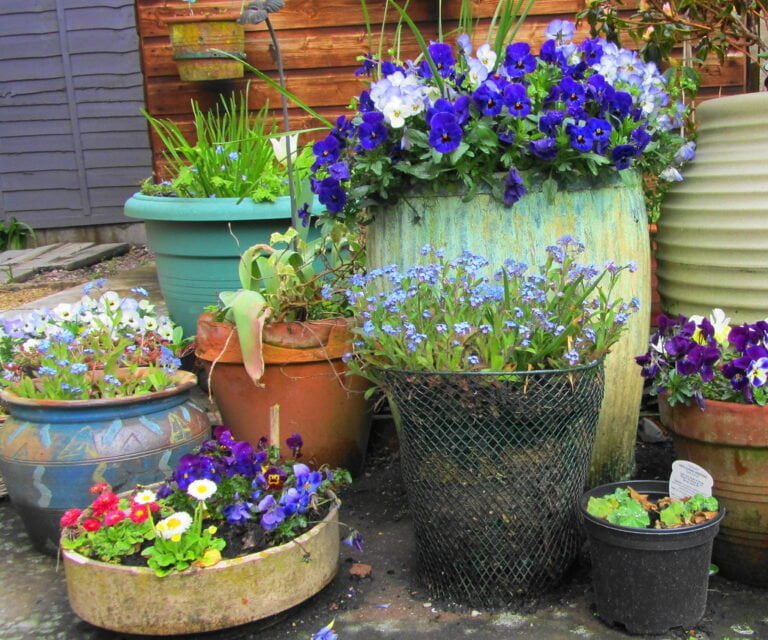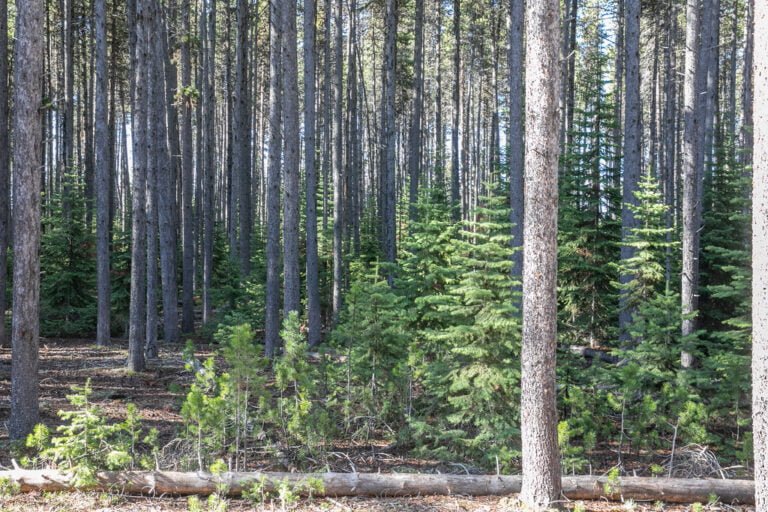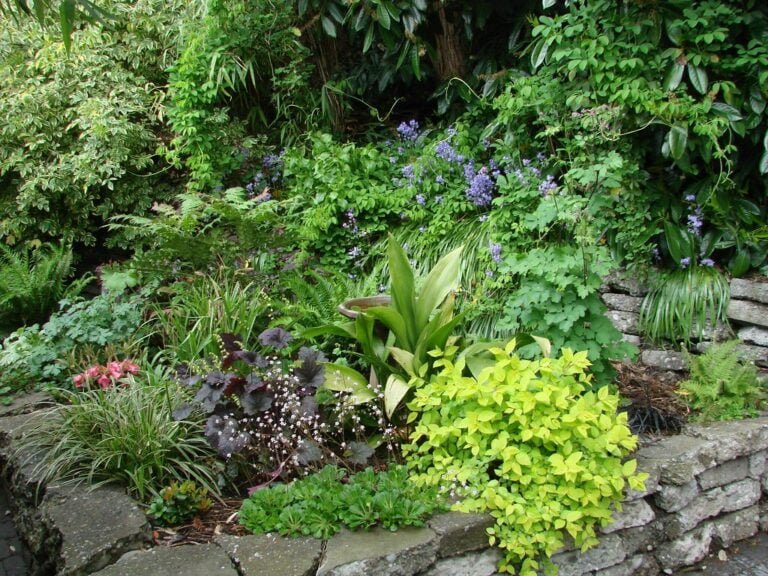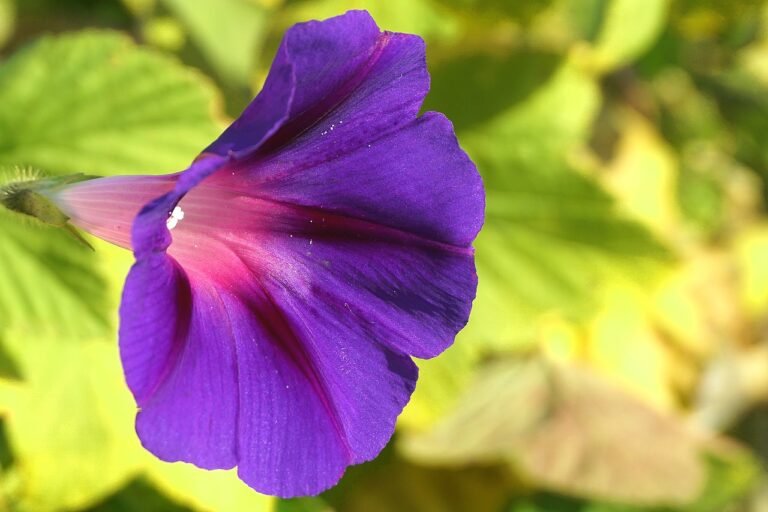Understanding Soil and Moisture Requirements for Shade Gardens
Understanding the soil and moisture needs for shade gardens is crucial for plant health. Assess soil type for proper pH levels and composition. Monitor moisture regularly, as it impacts nutrient uptake. Prevent fungal growth by improving drainage and mulching. Tailor watering to individual plant needs and group them accordingly. Enhance soil with organic matter for lush growth. Maintaining healthy levels guarantees thriving shade gardens. Consider the delicate balance between soil and moisture for peak plant vitality. Further details on creating a flourishing shade garden await exploration.
Importance of Understanding Shade Levels
Understanding the different levels of shade is essential for cultivating a thriving garden that caters to the specific light needs of plants. In shade gardens, the varying shade levels, including full shade, partial shade, dappled shade, and dense shade, play a pivotal role in determining plant growth. Different plants require different light conditions to thrive, and being able to identify these shade patterns is key to the success of your garden.
When it comes to plant placement, knowing the shade levels in your garden is paramount. Plants that prefer full shade will struggle if placed in an area with dappled or partial shade, impacting their growth and overall health. By monitoring the shade patterns that shift throughout the day and across seasons, you can adjust the placement of your plants accordingly to make sure they receive the best amount of sunlight.
Maintaining a balanced ecosystem in your shade garden relies heavily on properly evaluating shade levels. This evaluation allows you to select plants that are well-suited to the light conditions present, promoting their growth and vitality. By understanding the nuances of shade levels and their impact on plant health, you can set the foundation for a successful and flourishing garden.
Assessing Soil Type in Shade Gardens
When evaluating soil type in shade gardens, it’s essential to conduct a soil texture analysis to understand its composition. Additionally, testing the pH levels can provide insights into the soil’s acidity, influencing plant growth. These initial steps help in determining the necessary amendments and maintenance practices for ideal plant health in shaded areas.
Soil Texture Analysis
Examining soil type in shade gardens involves performing a soil texture analysis to determine the composition of soil particles present. This analysis is essential as different soil textures, such as sandy, loamy, and clay soils, exhibit varying water retention and drainage characteristics. Conducting a jar test can help identify the predominant soil type, guiding the selection of suitable plants for the garden. Sandy soils drain quickly but may necessitate more frequent watering, while clay soils retain moisture but can lead to waterlogging. Understanding the soil texture in shade gardens is vital for creating an environment where plants can thrive based on their specific soil requirements. By evaluating soil particles and their properties, gardeners can make informed decisions to promote healthy plant growth.
Ph Level Testing
To assess the soil type effectively in shade gardens, one must conduct pH level testing to determine the acidity or alkalinity of the soil. The pH of soil greatly impacts nutrient availability to plants in shade garden settings. Most plants thrive in a slightly acidic to neutral pH range of around 6.0 to 7.0. Testing the pH levels using a soil test kit is essential to identify any necessary amendments required to create an ideal growing environment for shade garden plants. Different plant species have varying pH preferences, making soil testing important for ensuring the health and vitality of the vegetation in shade gardens. By understanding and managing the pH levels of the soil, gardeners can promote robust plant growth and overall garden success.
Monitoring Moisture Levels for Plant Health
I suggest closely monitoring the moisture levels in your shade garden to guarantee ideal plant health. By regularly checking soil moisture either manually or with a soil moisture meter, you can prevent issues like root rot caused by overwatering. Adjust your watering techniques based on the signs of dryness and the specific moisture requirements of the plants in your garden.
Soil Moisture Importance
Regularly monitoring soil moisture levels is essential for maintaining peak plant health in shade gardens. Soil moisture plays a pivotal role in nutrient uptake and root growth, directly impacting the overall vitality of plants. Overwatering can lead to root rot and fungal diseases due to excessive moisture, while underwatering stresses plants, causing symptoms like wilting, yellowing leaves, and stunted growth. To accurately assess moisture levels, using a soil moisture meter is highly recommended. This tool enables precise monitoring, allowing gardeners to adjust watering practices accordingly. By keeping a close eye on soil moisture and responding appropriately, gardeners can make sure that their shade garden plants receive the necessary hydration needed for thriving growth and development.
Signs of Dryness
Observing the subtle indications of dryness in shade garden plants, such as wilting leaves and arid soil, is essential for monitoring moisture levels and ensuring ideal plant health. To effectively detect signs of dryness in your shade garden, pay attention to the following:
- Leaf Curling: Look for leaves that are curling at the edges, which is a common indicator of dehydration in plants.
- Browning: Browning of leaf edges or tips can signal that the plant is not receiving adequate moisture.
- Drooping: If you notice your plants are drooping, it may be a sign of water stress and insufficient hydration.
Utilizing a soil moisture meter can provide accurate readings to guide your watering practices, while mulching helps retain moisture in the soil, promoting healthier plant growth.
Proper Watering Techniques
To guarantee excellent health for your shade garden plants, closely monitoring moisture levels through proper watering techniques is essential. Start by checking the upper few inches of soil for dryness or utilize a soil moisture meter to determine when it’s time to water. When watering, make sure deep penetration to encourage robust root growth. Water plants deeply but less frequently to prevent waterlogging and promote ideal plant health. Adjust your watering schedule according to variables like weather conditions, plant varieties, soil composition, and drainage patterns. Mulching the soil in your shade garden can help retain moisture, decrease evaporation, and stabilize soil temperature. Consider employing drip irrigation or soaker hoses for efficient and targeted watering, reducing the risk of foliage diseases.
Preventing Fungal Growth in Shade Gardens
When managing shade gardens, ensuring proper watering practices, especially in the morning, is essential for preventing fungal growth. Here are three key steps to help you prevent fungal infections in your shade garden:
- Enhance Soil Drainage: Enhancing soil drainage in your shade garden is critical to decreasing moisture levels that can contribute to fungal growth. Consider incorporating organic matter into the soil to boost drainage and reduce the risk of standing water around your shade plants.
- Monitor Moisture Levels: Avoid overwatering your shade plants, as excess moisture can create an environment that is favorable for fungal pathogens. Regularly check the soil moisture levels and adjust your watering schedule accordingly to maintain ideal conditions for your plants.
- Use Organic Mulch: Using organic mulch in your shade garden can help regulate soil moisture levels and prevent the accumulation of water that may lead to fungal issues. Mulch also aids in maintaining a consistent soil temperature, which can further deter fungal growth.
Tailoring Watering Practices for Shade Plants
Tailoring watering practices for shade plants involves adjusting the frequency and depth of watering to meet the specific needs of these plants in low-light environments. In full shade areas where trees or shrubs block most sunlight, the soil tends to retain moisture better than in sun-exposed areas. This reduced evaporation rate means that shade plants generally require less frequent watering compared to those in sunny spots. However, it is vital to water shade plants deeply when needed to encourage root growth. Before watering again, always check the soil moisture to avoid overwatering, which can lead to root rot in shade plants.
When caring for shade plants, consider grouping them based on their light levels, soil preferences, and nutrient requirements. This practice ensures that plants with similar needs are together, making it easier to provide appropriate care. For instance, if you have shade plants that prefer acidic soil, such as azaleas or rhododendrons, grouping them together allows you to use specialized fertilizers tailored to their requirements. Monitoring shade plants regularly for signs of insect infestation is also critical, as these plants can be more susceptible to pests in low-light conditions. By tailoring watering practices and grouping plants effectively, you can create a thriving environment for your shade garden.
Creating a Thriving Shade Garden Environment
In optimizing the conditions for a thriving shade garden environment, it is important to guarantee that the soil provides sufficient drainage to prevent waterlogging and root rot. To create an ideal environment for shade garden plants, consider the following key steps:
- Improve Soil Structure with Organic Matter: Incorporating organic matter such as compost into the soil enriches its structure, promoting better aeration and drainage. This addition also enriches the soil with essential nutrients important for the healthy growth of shade-loving plants.
- Mulch for Moisture Conservation: Mulching the soil surface in shade gardens serves multiple purposes. It helps in retaining moisture, which is important for plants in shaded areas where sunlight is limited. Additionally, mulch acts as an insulator, regulating soil temperature and reducing water evaporation.
- Understand Tree Root Systems: When planting in the vicinity of trees in a shade garden, it is important to understand the root systems of the existing trees. Tree roots can compete with shade garden plants for water and nutrients, so proper planning to minimize this competition is crucial for the success of your shade garden.
Achieving Lushness in Shade Gardens
To achieve lushness in shade gardens, consistently monitoring and adjusting soil moisture levels is essential for the healthy growth of plants. Soil drainage plays a critical role in preventing waterlogging, especially in low light conditions typical of shade gardens. Incorporating organic matter, such as compost, into the soil improves its structure and provides essential nutrients for the plants to thrive. Mulching is another beneficial practice in shade gardens as it helps retain moisture, regulate soil temperature, and suppress weed growth.
Understanding the specific moisture requirements of the plants in your shade garden is important for maintaining their health and promoting lush growth. Monitoring the soil moisture levels regularly allows you to assess if the plants are receiving adequate water. Adjusting the watering frequency based on these observations ensures that the plants get the right amount of moisture, preventing issues like overwatering or underwatering.






